#azim premji success story
Text
Azim Premji's founder of Wipro- 6 mantras of Success for Entrepreneurs!

Wipro, which started out as a manufacturer of vegetable and refined oils in Amalner, Maharashtra's district Jalgaon, is credited with expanding thanks to Azim Premji, India's fourth richest man. The 69-year-old business tycoon took over at the young age of 21 and has since taught India's youth many of the things he acquired during his career.

A company the scale of Wipro, which is currently valued at $19.4 billion, cannot be built without the pursuit of excellence. Premji is a strict employer that holds himself and his team members to high standards. He believes that certain traits are necessary in employees who want to attain the highest levels of quality and accomplishment. The first of them is confidence.
Azim Premji Biography
Let's start the journey:
Azim Premji Early Life
Azim Premji was born into a Muslim Gujrati family in Bombay. His father, who was also a prosperous businessman and was sometimes referred to as the Rice King of Burma, gave him his entrepreneurial spirit. As an Indian, I am extremely grateful to God that Muhammed Hashem Premji refused the invitation from the founder of Pakistan, Muhammad Ali Jinnah, to visit Pakistan.
Premji decided on a Stanford University Bachelor of Science in Electrical Engineering. Rashid and Tariq, the couple's two kids, were born to him and Mrs. Yasmeen Premji. At the moment, Rishad Premji serves as Wipro's chief strategy officer for the IT division.
Azim Premji Success Story
Muhammad Hashim Premji founded Western Indian Products Ltd. in 1945. It produced soap with the brand name 787 and cooking oil with the name Sunflower Vanaspati. After his father passed away in 1966, Azim Premji returned from Stanford University and assumed control of Wipro. Wipro used to deal in hydrogenated oil, but Azim Premji later expanded the business to include hair care, lighting goods, baby toiletries, baking fats, and toiletries. Premji joined the technology field by producing minicomputers with the assistance of an American business, Sentinel Computer Corporation, in the 1980s after seeing the promising future of the information technology sector. The rest is history.
Azim Premji Net-Worth
Azim Premji's net worth was estimated at 990 billion dollars, while Wipro's net worth is expected to reach 42.96 billion dollars by 2022.
Social Work By Azim Premji
"I really think that those of us, who are fortunate to have riches, should contribute meaningfully to try to build a better world for the millions who are far less fortunate," Azim Premji remarked.
In 2001, Azim Premji established the nonprofit Azim Premji Foundation with the goal of advancing education in India. He committed to provide one of India's largest gifts of $2 billion in 2010 to support the country's educational system. In 2019, he donated to the charity 34% of his Wipro stock holdings.
Bill Gates and Warren Buffett's "The Giving Pledge" initiative, which asks the world's wealthiest individuals to commit to giving the majority of their money to philanthropic organisations, has his support. By accomplishing this, Azim Premji became the first Indian to join The Giving Pledge.
Azim Premji has a reputation for being generous, and in 2013 he made the announcement that he would donate half of his fortune by signing the Pledge. His Azim Premji Foundation is committed to giving every kid in India a free education, and he has so far contributed almost $2.2 billion to do so.
Read This Full ARTICLE, Click Here
#azim premji success story#azim premji net worth#azim premji biography#azim premji chairman of wipro
0 notes
Text
Success Story: कभी सिर्फ 2 रुपये हफ्ते से शुरू किया गया था यह कारोबार, आज अरबों में हो रही कमाई
Success Story: कभी सिर्फ 2 रुपये हफ्ते से शुरू किया गया था यह कारोबार, आज अरबों में हो रही कमाई
नई दिल्ली. विप्रो के संस्थापक व चेयरमैन अजीम प्रेमजी (Azim Premji) का नाम आज पूरी दुनिया में मशहूर है. प्रेमजी अप���ी दूरदर्शी सोच और मेहनत से विप्रो को पूरी दुनिया में नई पहचान दिला दी. प्रेम जी का नाम सबसे रईस भारतीयों में शामिल है. बता दें कि विप्रो (Wipro) के संस्थापक अजीम प्रेमजी के दादा ने कभी सिर्फ 2 रुपये प्रति सप्ताह से शुरुआत करके सबसे बड़ी राइस ट्रेडिंग कंपनियों में से एक की स्थापनी की…
View On WordPress
0 notes
Text
Transforming Futures: The Role of Child Education NGOs in India
Introduction
Child education NGOs in India are at the forefront of ensuring that every child, regardless of their socio-economic background, has access to quality education. These organizations address educational disparities and work towards creating a brighter future for underprivileged children. In this article, we explore the pivotal role of child education NGOs in India, their key initiatives, challenges, and the profound impact they have on society.
Addressing Educational Disparities
Bridging the Gap
Child education NGOs play a crucial role in bridging the educational divide between urban and rural areas. By establishing schools and learning centers in remote regions, these organizations provide access to education where it is needed the most.
Inclusive Education
NGOs such as Pratham and Save the Children focus on inclusive education, ensuring that children with disabilities and those from marginalized communities receive the support they need to thrive academically.
Key Initiatives of Child Education NGOs
School Infrastructure Development
Many NGOs invest in developing school infrastructure, including building classrooms, providing furniture, and setting up libraries. Organizations like Smile Foundation and Akshaya Patra also focus on creating a conducive learning environment by ensuring clean drinking water and sanitation facilities.
Teacher Training Programs
Ensuring quality education requires well-trained teachers. NGOs such as Teach For India and Azim Premji Foundation conduct teacher training programs to enhance teaching methodologies and pedagogical skills, thereby improving the overall quality of education.
Digital Education and E-Learning
In the digital age, access to technology is crucial for modern education. NGOs like eVidyaloka and Digital Empowerment Foundation leverage technology to provide digital learning resources, online classes, and e-learning platforms, ensuring that children in remote areas are not left behind.
Community Engagement and Empowerment
Parental Involvement
Child education NGOs recognize the importance of involving parents in their children's education. Workshops and training sessions help parents understand the value of education and equip them with the tools to support their children's learning journey.
Community Awareness Programs
NGOs engage with local communities through awareness programs, highlighting the importance of education and encouraging community participation. This approach helps in building a supportive environment for children's education.
Overcoming Challenges
Reducing Dropout Rates
High dropout rates are a significant challenge in many parts of India. Child education NGOs address this issue by implementing flexible schooling hours, providing mid-day meals, and offering vocational training programs to keep children engaged and motivated.
Ensuring Sustainable Funding
Sustainable funding is crucial for the continuity of educational programs. NGOs often collaborate with corporate partners, international organizations, and government agencies to secure the necessary resources for their initiatives.
Impact and Success Stories
Transforming Lives Through Education
The impact of child education NGOs can be seen in the success stories of countless children who have overcome adversity to achieve academic success. These organizations provide not just education but also hope and a pathway to a better future.
Long-Term Community Benefits
Educated children grow up to be informed, responsible citizens who contribute positively to their communities. The ripple effect of education extends beyond individuals, fostering economic growth and social development in the long term.
Conclusion
Child education NGOs in India are instrumental in shaping the future of the nation by ensuring that every child has the opportunity to learn and succeed. Their dedication to addressing educational disparities, engaging communities, and overcoming challenges underscores their vital role in building a brighter, more equitable future for all. Through continuous efforts and innovative approaches, these organizations are transforming lives and paving the way for sustainable development.
0 notes
Text
Global Indians: A Journey of Influence and Impact
In today's interconnected world, the concept of nationality and identity has transcended borders, creating a global community that is more diverse and dynamic than ever before. Among the numerous diaspora communities around the world, one group stands out: the "Global Indians." These individuals, often of Indian origin, have made significant contributions in various fields and have left an indelible mark on the global stage.
The Global Indian Diaspora
The term "Global Indians" refers to people of Indian origin who reside outside of India but maintain strong connections to their cultural roots. With a vast and vibrant diaspora spread across the globe, this community has become a driving force behind several aspects of the world's cultural, economic, and political landscapes.
Economic Powerhouses
One of the most prominent aspects of the Global Indian community is its influence on the global economy. Indian entrepreneurs and business leaders have established successful companies in various industries, including technology, healthcare, finance, and entertainment. Names like Sundar Pichai (CEO of Google), Indra Nooyi (former CEO of PepsiCo), and Ratan Tata (chairman of Tata Group) are synonymous with success and innovation on the international stage. Their leadership and entrepreneurial spirit have not only created wealth but also generated job opportunities worldwide.
Cultural Ambassadors
Global Indians have also made significant contributions to the world of arts and culture. Actors like Priyanka Chopra and Mindy Kaling have become household names in Hollywood, breaking barriers and stereotypes along the way. The global reach of Bollywood has further facilitated cultural exchange, making Indian music, dance, and fashion integral components of the global cultural tapestry. Additionally, writers like Arundhati Roy and Jhumpa Lahiri have garnered international acclaim for their literary works, further promoting Indian literature and thought.
Philanthropic Efforts
Global Indians are not just making waves in the corporate and entertainment worlds; they are also actively engaged in philanthropic activities. Individuals like Ratan Tata, Azim Premji, and N.R. Narayana Murthy have pledged substantial amounts of their wealth to support causes such as education, healthcare, and poverty alleviation on a global scale. These acts of generosity showcase the community's commitment to making a positive impact beyond financial success.
Political Involvement
In the realm of politics, Global Indians have played a significant role in various countries, contributing to legislative, diplomatic, and governance processes. Prominent figures like Kamala Harris, who became the first female Vice President of the United States and the highest-ranking Indian American in U.S. political history, exemplify the community's growing influence on the world stage.
Challenges Faced by Global Indians
While Global Indians have achieved remarkable success, they continue to grapple with certain challenges. Issues related to identity, belonging, and discrimination persist, with many individuals facing prejudices and stereotypes based on their ethnicity or origin. Additionally, navigating the complexities of dual citizenship and cultural integration can be a delicate balance.
Conclusion
The story of Global Indians is a testament to the power of the human spirit and the potential for individuals to make a significant impact on a global scale. Through their economic contributions, cultural influence, philanthropic endeavors, and political involvement, Global Indians have reshaped the narrative of the Indian diaspora.
As the world becomes increasingly interconnected, it is essential to celebrate and support the diverse contributions of Global Indians. Their journey reflects the idea that one's identity is not confined to a single nation but can be a powerful force for positive change and progress on a global stage.
0 notes
Text
Wipro's Remarkable Transformation: From Oil to IT Powerhouse

Wipro, a global IT services company headquartered in India, boasts a rich history that exemplifies the transformative power of innovation and adaptability. Founded in 1945, Wipro initially ventured into the business of manufacturing vegetable and refined oils, setting the stage for a remarkable journey that would eventually lead the company to become a formidable force in the world of information technology (IT).
Founding Years and Early Ventures
Wipro's origins trace back to its founder, Mohamed Hasham Premji, who started the Western India Vegetable Products Limited as a modest manufacturer of cooking oil in Amalner, Maharashtra. In the early years, the company primarily focused on producing vegetable oil and other consumer goods.
Diversification into IT
The turning point for Wipro came in the late 1970s when the company, under the leadership of Azim Premji, the founder's son, recognized the potential of the emerging IT industry. Azim Premji played a pivotal role in steering the company toward diversification, laying the foundation for Wipro's foray into the world of IT services.
Pioneering IT Services
Wipro's initial steps into the IT sector included manufacturing computer hardware and software, marking the company's transition from a traditional manufacturing enterprise to an IT pioneer. In 1980, Wipro began manufacturing its first computer, the Wipro PC.
Global Expansion
The 1990s marked a significant period of expansion for Wipro's IT services division. The company extended its global footprint by establishing offices and delivery centers in the United States and Europe. This expansion allowed Wipro to tap into a broader client base and gain international recognition.
Key Acquisitions
Wipro's growth in the IT sector was further accelerated through strategic acquisitions. In 1999, the company acquired the American IT consulting firm Spectramind, which helped Wipro expand its BPO (Business Process Outsourcing) services. This move was instrumental in diversifying its IT offerings.
Becoming a Global IT Giant
In the early 2000s, Wipro continued to strengthen its position as a global IT powerhouse. It expanded its service portfolio to include software development, IT consulting, and outsourcing services. The company's commitment to innovation and quality allowed it to secure partnerships with leading global corporations.
Focus on Sustainability and CSR
As Wipro evolved, it also embraced a strong commitment to sustainability and corporate social responsibility (CSR). Under Azim Premji's leadership, the company implemented several initiatives to promote environmental sustainability and philanthropic activities, contributing to its positive global image.
Wipro's Impact Today
Today, Wipro is a leading global IT services provider, offering a wide range of services that include software development, IT consulting, cybersecurity, and cloud computing. The company serves clients across diverse industries, including healthcare, finance, and technology.
Wipro's journey from its humble beginnings in the oil industry to its current stature as an IT giant is a testament to the company's adaptability, visionary leadership, and commitment to excellence. This transformation reflects the broader shift of businesses worldwide toward the IT sector, where innovation and agility are essential for success. Wipro's remarkable story serves as an inspiration for companies seeking to reinvent themselves in the face of evolving market dynamics, illustrating how strategic diversification and a focus on emerging technologies can lead to enduring success in the ever-changing business landscape.
Read the full article
0 notes
Text
A Farmer Who Become Billionaire By Investing In Stock Market
This is the Stock Market Success Story Of A Farmer Who Became Billionaire Just By Investing In Just Stocks Of Only One Wipro .
Name Of The Person Is Mohammad Anwar . He Own Stock Of Wipro Worth More Than 800 Crore. He Invest In That Company At Time When It Was Started by Mr. Azim Premji And Was at Starting Phase Where He Invest Just Rs.10,000 . That 10,000 Was What He Get By Selling Land Of…

View On WordPress
#Farmer Invest In Stock Market#Long Term Investment In Stock Market#Mohammad Anwar Wipro#Mohammad Anwar Wipro Success Story#Stock Market#Wipro
0 notes
Text
5 Must Listen Audiobooks For Everyone
In life, there are things you could do, things you should do, and things you must do. These same categories apply to the choice of book you listen next. You could listen any number of books, for reasons ranging from guilty pleasure to the fact that your book club meets in two days.
Below is the list of 5 Must Listen Audiobooks for Everyone. Everyone should listen to these books published by HarperCollins India.
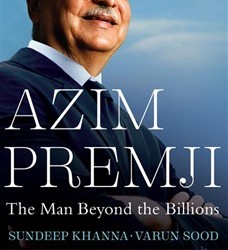
1. Azim Premji by Sundeep Khanna | Varun Sood
Azim Premji: The Man Beyond the Billions, the first authoritative biography of the icon, shows how Premji is a philanthropist at heart and a businessman by choice – a man who wanted to give away his billions but realized early enough that he would first have to earn them. It peels the layers off Premji’s life while chronicling his professional and charitable work in the context of his many strengths and shortcomings.
Buy Now!

2. I Came Upon a Lighthouse by Shantanu Naidu
In 2014, Shantanu Naidu, an automobile design engineer in his early twenties, developed an innovation to save the local strays from being run over by speeding cars. Ratan Tata, himself known for his compassion for stray dogs, took note. Impressed, he not only decided to invest in the venture, but over the years became a mentor, boss and an unexpectedly dear friend to Shantanu.
I Came Upon a Lighthouse is an honest, light-hearted telling of this uncommon bond between a millennial and an octogenarian that gives glimpses of a beloved Indian icon in a warm light.
Buy Now!

3. Yes Man by Pavan C. Lall
Yes Man is the story of Rana Kapoor, and his Icarus-like flight that eventually led to the Yes Bank crisis. From starting out as a junior employee at Bank of America to leading a bank worth billions, Kapoor’s rise and fall is a case study in ambition, greed and deceit. In this hard-hitting book, Pavan C. Lall details not only Rana Kapoor’s journey, but also asks tough questions about the banking system, its regulators and even the business environment that led to a point of no return for Yes Bank.
Buy Now!

4. A Patchwork Quilt by Sai Paranjpye
Sai started her career at All India Radio, later graduating from the National School of Drama and making her way into theatre, television, documentaries and movies, working with some of the most highly regarded names of the Hindi film world. She met with success in the world of books too, her Marathi translation of Naseeruddin Shah’s memoir winning her the Sahitya Akademi award in 2019.
Frank, forthright, full of anecdotes and written with a flair for recounting her multifarious journey in lively detail, A Patchwork Quilt is Sai Paranjpye’s memoir that looks back on a life well lived.
Buy Now!

5. Nothing to Lose by Manbeena Sandhu
From heading an ashram at Rajneeshpuram, Oregon, USA, in the 1980s to allegedly spearheading what is known as the largest bioterror attack in American history and spending thirty-nine months in prison, Ma Anand Sheela’s life is one that fascinates and intrigues.
But who is the woman beyond the persona of the commune leader? What is Sheela like behind the sensational ‘tough titties’ avatar?
Manbeena Sandhu followed the Osho movement for two decades before her journey finally led her to Sheela. Nothing to Lose is a no-holds-barred account of Sheela’s life, her intense relationship with Bhagwan, and the riveting story of what actually happened behind the closed doors of the cult’s ashram.
Buy Now!
0 notes
Text
अज़ीम प्रेमजी: कहानी बिजनेस के बादशाह और सबसे बड़े दानवीर की
अज़ीम प्रेमजी: कहानी बिजनेस के बादशाह और सबसे बड़े दानवीर की
नई दिल्ली. अज़ीम प्रेमजी (Azim Premji) भारत की एक ऐसी शख्सियत हैं, जिन्हें लोग बिजनेसमैन के तौर पर कम और परोपकारी दानवीर को तौर पर ज्यादा जानते हैं. प्रेमजी भारत टॉप IT कंपनियों में से एक विप्रो (Wipro) के फाउंडर हैं. विप्रो की नेटवर्थ 3 लाख 46 हजार 537 करोड़ रुपये है (30 अगस्त 2021 को). एक छोटी-सी कंपनी कैसे लाखों करोड़ की मल्टी नेशनल कॉर्पोरेशन (MNC) में बदल गई, इसे समझने के लिए आपको जानना होगा…
View On WordPress
#Azim Premji#Azim Premji Biography#Azim Premji Donation#Azim Premji Life Story#Wipro Limited#Wipro Success Story
0 notes
Text
Azim Premji's founder of Wipro- 6 mantras of Success for Entrepreneurs!

Entrepreneur, investor, engineer, and philanthropist Azim Premji is also a businessman. He serves as Wipro's founding chairman and a non-executive board member. Wipro, which was formerly a manufacturer of vegetable and refined oils in Amalner, district Jalgaon in Maharashtra, is credited with diversifying due to Azim Premji, the richest tech entrepreneur in India.
Set lofty objectives for yourself and make it your life's purpose to achieve them. Azim Premji believes that innovation can't be achieved at the expense of ignoring previous lessons and failing to comprehend context. Differences of opinion are unavoidable in an environment that thrives on ideas. The same is true in social situations. Let's look at the Success Story of Azim Premji and the lesson we can learn from it.
Azim Premji, India's fourth richest man, is credited with broadening Wipro, which began as a maker of vegetable and refined oils in Amalner, Maharashtra's district Jalgaon. The 69-year-old business magnate assumed command at the tender age of 21 and has since shared many of the lessons he learned throughout his career with India's youth.
Without the pursuit of perfection, it's impossible to establish a juggernaut the size of Wipro, which is today valued at $19.4 billion. Premji is a demanding boss who demands the best from his leaders and employees, as well as himself. Certain characteristics, he feels, are essential in personnel aspiring to the greatest levels of quality and achievement. Self-assurance is one of them.
Azim Premji Biography
Let's start the journey:
Azim Premji Early Life
Azim Premji was born in Bombay in a Gujrati Muslim Family. He got his business mindset from his father, who was also a successful businessman and was often called the Rice King of Burma. The founding father of Pakistan, “ Muhammed Ali Jinnah” invited his father Muhammed Hashem Premji to Pakistan, but he declined his offer, and as an Indian, I am very thankful to God that he did.
Premji opted for a Bachelor Of Science in Electrical Engineering degree from Stanford University. He is married to Mrs. Yasmeen Premji, and the couple has two children together, Rashid and Tariq. Currently, Rishad Premji is the chief strategy officer of the IT business in his father’s company, Wipro.
To Read This Full ARTICLE, Click Here
0 notes
Text
The real Business motivation is here.
This is about Azim Premji, Wipro technologies
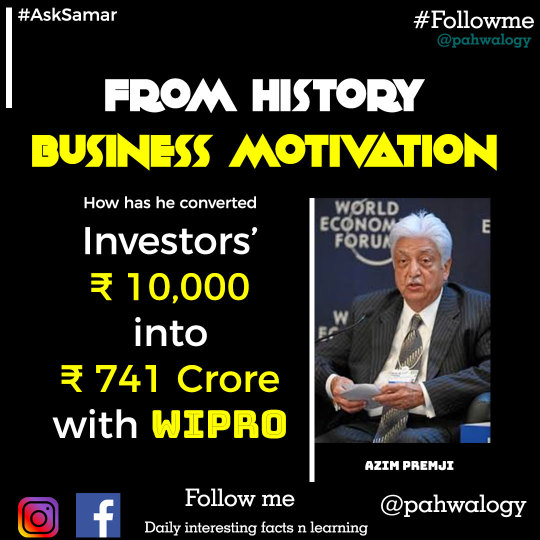
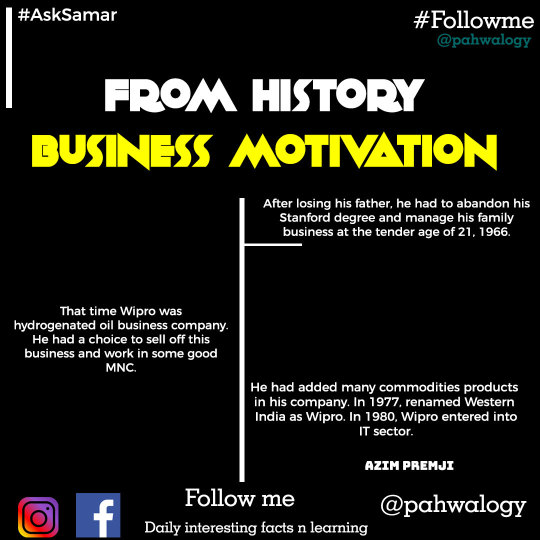
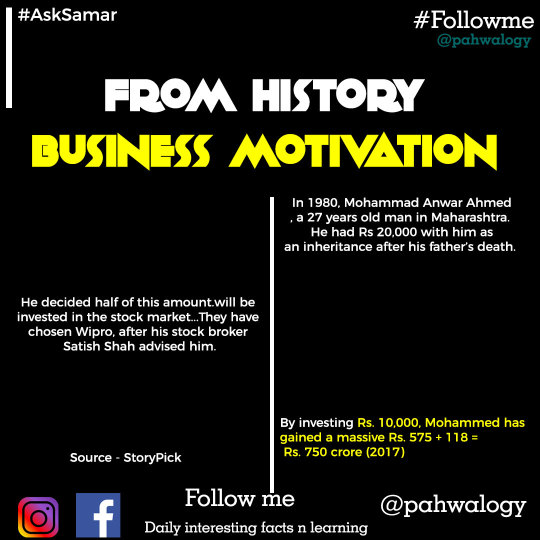

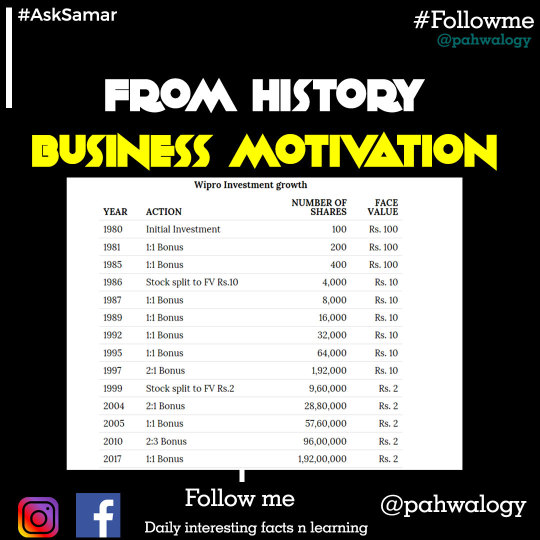
#azim premji#Wipro#wipro technologies#success story#billion dollars#trillion dollars#startup#startup business#businessideas#business
0 notes
Text
The rise, fall, and rise of SB Packagings

This story has been in the making for over two years but events kept overtaking it. There was the pandemic, but the flexible packaging industry became stronger, SB Packagings’ new film lines and gravure press arrived and were installed. Equity investment came in. The WorldStar award was won. Further orders for another blown film line and new presses were breaking news even as this story was being written and rewritten with SBP’s inputs. This is the kind of story that will continue to be overtaken by events but one has to freeze the frame somewhere and get it out as soon as one can. – Naresh Khanna
It is very difficult to believe that a company that was still sick less than ten years ago is now setting new standards in the flexible packaging industry and is on a growth trajectory of its own, seemingly oblivious of the competition. SB Packagings was founded in 1991 by OP Banga and established on the outskirts of Delhi in what is now included in the Delhi-NCR. Banga was joined in 1992 by his son Amit after he completed his MBA from a reputed business school. Amit Banga says he would have become a banker if it wasn’t for the opportunity afforded by his father’s business.
Speaking about how the name ‘SB Packagings’ came about, Om Prakash Banga reminisces about his erstwhile partners the Sethi family. Together they founded SB Chemicals, the parent firm that subsequently diversified to packaging as SB Packagings.
The company primarily produces recyclable monolayer PE flexible packaging in the form of both rolls and pouches for a wide range of consumer product companies, in both food and non-food segments. It has championed the use of PE in India and is a leader in the hygiene segments – particularly diapers and sanitary napkins. Initially, SBP was a small-scale unit for manufacturing monolayer PE bags for Unilever for its detergent brands such as Surf, Rin, Vim, and Wheel and this has remained the DNA of SBP.
Each of the past decades has been an extreme roller coaster ride for SB Packagings’ business. The perseverance in resolving the company’s ups and downs has eventually been rewarded with successful expansion in the past decade. In the past year, one of India’s most respected industrialists and investors, Azim Premji has made a substantial investment in the company to take it to the next level.
Reengineering the upward climb
From its first-year turnover of Indian Rupees 20 million in 1993-94, SBP grew leaps and bounds to a turnover of Indian Rupees 700 million over the next decade. Ahead of the times, SBP was the first converter to invest in a CI flexo press, a natural expansion for its PE film business in the year 2000.
Along with the flexo press came a solventless laminator, one of the first in the country. However, a breakthrough into the food business with the new concept of solventless lamination was not easy with high gestation periods for qualification with big brands. Additionally, the flexo process was not able to compete with the well-entrenched gravure printing industry in Asia, especially in India.
On top of these challenges, polymer prices shot up due to the Gulf war and it was difficult to pass on the price increase to its big buyers. This was the perfect storm and thus began the financial downturn for SBP. The losses wiped out its working capital and the company lost many of its employees who left the ship thinking it was sinking. Those who had faith in the promoters stayed behind. Some of the suppliers took the rug out from under the company’s feet while those who knew the Bangas better kept the faith and continue their support.
Amit Banga rolled up his sleeves and took the driving seat. Supported by his father, he gradually invested all the personal assets of the family into reviving the business. Putting up a brave face in front of the banks, worried suppliers, and anxious team members, he set upon the long and arduous task of rebuilding the company.
Its depleted working capital forced the company to stick to more profitable customers and value-added business segments. Reengineering the product mix led to the exfoliation of the unprofitable businesses and a strategy to stick to its core competency – the monolayer PE business. Extrusion of thin PE films for surface printing with gravure and flexo presses was a challenge for the industry and SBP had the capability and experience to take it on.
The upward trajectory, significant investments, and breaking news!
P&G was one of the first new clients who needed SBP as much as the converter needed the brand owner and thus began a long partnership, which remains stronger than ever. With this reengineering of the product mix and a plan to stick to its core competencies, the second coming of SBP gained traction with several clients who had faith in its capabilities. These brand owners have backed the company over its past fifteen years of success and growth.
The downturn beginning in 2003 was reversed by the end of the decade and a new growth trajectory emerged. First came a fresh investment in a gravure press, a PE blown film line, and specialized bagmaking machines in 2014, and then a state-of-the-art 8-color CI flexo press from Uteco and another PE blown film line and additional bagmaking machines in 2017.
Thereafter there was no looking back. More PE blown film lines and bag-making machines followed and then came the big combo of a 10-color press with full automation and a 3-meter-wide PE blown film line from the world leader Windmoeller and Hoelscher in 2020. There is breaking news that SBP has just given a repeat order for the same combination again to W&H. At the same time, there is a repeat order to Kohli Industries for a second gravure press from that company.
Premji Invest comes into the picture
In August 2021, Premji Invest, Wipro chairman emeritus Azim Premji’s family office company, invested US$ 25 million (approximately Rs 180 crore) in SB Packagings for capacity growth and acquisitions. “With the backing from Premji Invest, one of India’s leading private equity investors, we look forward to further expanding our capabilities through organic and inorganic routes, thereby strengthening our position in the Indian flexible packaging industry,” says Amit Banga.
In the last decade, SB Packaging has won numerous Indian and International awards for its excellent PE printing capabilities and environment-friendly packaging products. After winning the IndiaStar and the AsiaStar Awards for 2020, SBP recently won the most coveted packaging award in the world, the WorldStar 2022 Award for Innovative Sustainable Packaging, for its unique innovation of “100% Recyclable Stand-up Pouch with Spout and High Barrier.”
SBP produces one of the widest ranges of PE bags and pouches in the world and has the capability to replace most multilayered packaging (MLP) with 100% PE-based packaging. It has taken on one of the last bastions of multilayered packaging, by winning the WorldStar Award for 100% Recyclable Stand-up Pouch with Spout and High Barrier made of monolayer PE for liquid packaging. The award will be presented at the forthcoming Ipack-Ima exhibition in Milan at the ceremony on 4 May 2022.
“Our perseverance and faith in building a business model around the needs of the society are finally paying off, though it is still a long and winding road ahead,” says Banga. “It is quite amusing to look back and realize that ‘sustainability’ was not a buzzword when we started focusing on environment-friendly packaging almost two decades ago. While there is a lot of noise now, it is just the start of a new journey. The brand owners in India are still waiting for a regulatory push, but for us now, the world is a market. So, we will focus on whoever wants it first.
“With the government imposing Extended Producer Responsibility (EPR) for both the brand owner and the producer of plastic packaging, the obligation to recycle and utilize recycled material has begun and it is critical for brand owners to promptly cut their usage of plastic raw material in order to reduce their obligations. “We are ready when they are.”
0 notes
Text
Global Indians: Making Waves Across the World
In an increasingly interconnected world, the Indian diaspora, often referred to as "Global Indians," has been making a significant impact in various fields worldwide. From technology to business, arts, and academia, individuals of Indian origin have been contributing to global progress and shaping the landscape of diverse industries. In this blog, we'll explore the journey of Global Indians, their achievements, and the influence they wield across the globe.
The Global Indian Diaspora: A Brief Overview
The Indian diaspora is one of the largest in the world, with an estimated 17.5 million people of Indian descent living outside India. This vibrant and diverse community has played a crucial role in shaping the global narrative. Here are a few areas where Global Indians have made a substantial impact:
1. Technology and Entrepreneurship
Silicon Valley, often dubbed as the technology hub of the world, is a testament to the influence of Indian entrepreneurs. The list of successful Indian-origin tech leaders includes the likes of Sundar Pichai (CEO of Google), Satya Nadella (CEO of Microsoft), and Arvind Krishna (CEO of IBM). Their visionary leadership and innovative thinking have helped drive the digital revolution and redefine the way we live and work.
2. Business and Finance
Global Indians have made their mark in the world of business and finance, with leaders like Indra Nooyi (former CEO of PepsiCo), Anshu Jain (former co-CEO of Deutsche Bank), and Ajay Banga (former CEO of Mastercard). They've steered multinational corporations and financial institutions, contributing to economic growth and global financial stability.
3. Academia and Research
Indian scholars and researchers have excelled in academia, with individuals like Venkatraman Ramakrishnan (Nobel Laureate in Chemistry), Amartya Sen (Nobel Laureate in Economics), and Shafi Goldwasser (Turing Award recipient). Their contributions to the fields of science, economics, and computer science have expanded our understanding of the world.
4. Arts and Entertainment
Global Indians have also left their mark on the entertainment industry. Actors like Priyanka Chopra and Mindy Kaling have achieved international recognition, while authors like Jhumpa Lahiri and Arundhati Roy have received critical acclaim for their literary contributions.
5. Philanthropy and Social Impact
Global Indians have not only excelled professionally but have also shown a commitment to philanthropy and social causes. Figures like Ratan Tata, who leads the Tata Trusts, and Azim Premji, known for his generous donations to education and healthcare, exemplify this dedication to giving back to society.
Challenges and Opportunities
While Global Indians have made immense strides across the world, they face unique challenges, including issues related to identity, cultural assimilation, and discrimination. However, their resilience, adaptability, and commitment to excellence have enabled them to overcome these obstacles.
Conclusion
The Global Indian diaspora represents a remarkable story of success, resilience, and the ability to adapt and thrive in diverse cultures and societies. Their achievements across various fields serve as an inspiration to millions and reinforce the idea that talent knows no borders. As Global Indians continue to excel and make their presence felt worldwide, they play an integral role in shaping the global narrative and contributing to progress and innovation. Their story is a testament to the power of diversity and the human spirit.
1 note
·
View note
Text
Is Leaving College For Building a Business A Good Idea?

What do Bill Gates, Steve Jobs, Mark Zuckerberg, Michael Dell, and Azim Premji have in common other than being billionaires? They are college dropouts!
Yes, these are some of the most successful people we know who dropped out of college and challenged the norms. They are billionaires not by accident, but by design. Nowadays everyone wants to be the next Mark or the next Jobs. But one question remains. Is it worth pursuing a college education if some of the most successful people dropped out from even some of the top colleges?
Is College Education Worth It?
Of course! A college education is worth your time and effort. But there is a catch. Just like anything in this world, a college degree is only as good as how you decide to use it. Even if you have a degree from MIT or Stanford, it doesn’t mean that you can be a billionaire. What you decide to do with the degree is more important than achieving the degree itself.
In most cases, college education gives you more exposure, knowledge, and, more importantly, industry connections. networking is one area where college education can really help you. It has a huge network of influential professors and an alumni network.
Is it worth pursuing a college education if some of the most successful people dropped out from even some of the top colleges? Of course! A college education is worth your time and effort. But there is a catch.Click To Tweet
Now, many people ask the question, “But most of these graduates aren’t billionaires. So why should I pursue a degree when people have proven that we can be successful without it?”
There is no one-size-fits-all answer to this question. It mostly depends on the person asking this question.
Why everyone is not cut out to be an entrepreneur?
- Entrepreneurship is hard. You need to keep hustling all the time, make compromises on personal preferences, and work the first few years as no one else will work in the hopes that it will play out well for you in the long run. Not many people can carry it till the end. Those who can, usually ends up being successful
- You cannot identify a real problem to solve. A successful business is something that solves a real problem. Unless you can figure out a solution to a problem people are willing to pay money for, you are not in business
- You are not comfortable taking risks. If this is you, then entrepreneurship is definitely not for you. You need to take big risks when you are running a business. Identifying opportunities and acting at the right moment is critical for business success
When can you afford to skip college education?
All is not doom and gloom.
What makes entrepreneurship so attractive is the challenges that come with it. You don’t need a Ph.D. or even a college degree to become a successful entrepreneur. All you need is the ability to take risks, the mentality to push forward even when things seem horribly wrong, and the correct mindset to identify opportunities and act at the right time.
If you are confident about your skills and abilities, skipping a college education may be worth it. You can put the money you might use for paying tuition fees to build a solid business that solves real-world problems.
Over to You Now:
What do you think? Is leaving college good or bad? Do you think students might be misled by success stories of entrepreneurs who dropped out of college?
The McGraw-Hill Guide to Starting Your Own Business : A Step-By-Step Blueprint for the First-Time Entrepreneur
$10.45
Buy Now
We earn a commission if you click this link and make a purchase at no additional cost to you.
10/04/2021 02:57 pm GMT
Read the full article
0 notes
Text
Harsh Realities: A book on The Making of Marico by Harsh Mariwala
'Harsh rolled up his sleeves and went into the field and learnt the business from the ground up-starting with the consumer and then led the company to where it is today through a combination of genius and toil. A must-read'
-- Sanjeev Bikhchandani, co-founder, Naukri.com
'A truly riveting story of how an iconic leader with purpose, persistence and passion leverages customer-centric innovation driven by uncommon thinking to create a world-class enterprise. An inspiring "must-read" for all'
-- Dr R.A. Mashelkar, National Research Professor, and former director general, Council of Scientific and Industrial Research
'The story of Harsh Mariwala is a fascinating tale of a man born in a traditional joint family, finding place and meaning in the family journey, using his instincts and natural intelligence to grasp opportunity, in passionate pursuit to understand the customer, and navigating his way to create a unique and ethical consumer company, Marico. I have known Harsh since his Kanji Morarji days, seen him carve out his consumer business from the traditional trading business and transition to a fully professional company. Marico is an outstanding example of an Indian multinational comparable to the best-in-class global consumer companies'
-- Uday Kotak, managing director and CEO, Kotak Mahindra Bank
'Harsh Mariwala's love for innovation, process orientation and building organizational culture is absolutely inspiring, and Marico is a glowing testimony of this. As revealed in this finely penned memoir, Harsh is a combination of spice and calm, as the two major products in his business, pepper and coconut oil. There is a mystical balance in him-traditional yet cutting-edge, searching yet grateful, restless yet transcendent, observing yet couldn't-care-less, loving yet impatient, and it is this potent mix that has helped nurture an outstanding organization and a fine human being. This book is the real "What they don't teach you at Harvard"'
-- Harsh Goenka, chairman, RPG Enterprises
'I have known Harsh for several years, and the inspiring story of how he discovered his purpose of "making a difference", of scaling up, failing, learning and striving to succeed-as he puts it-makes for a very insightful read. I enjoyed how he weaves in many other stories too, including the genesis of Marico, the evolution of a family business and the changing industrial landscapes, all of it underscored by the importance of grounded, values-based leadership. Prof. Ram Charan's reflections on Harsh's personal growth journey are a wonderful addition'
-- Adi Godrej, chairman, the Godrej Group
'Running a family-run business is no easy feat. And to take that to heights is a success story beyond one's imaginations. Harsh makes each of his struggles so relatable in this memoir. Superbly inspiring'
-- Rajiv Bajaj, managing director, Bajaj Auto
'This memoir is like reading three books in one. Firstly, there is the incredible story of Marico, its birth and how Harsh grew it to today's success. Second, Harsh's own thoughtful reflections on the journey he has been through. And finally, there are insights from the legendary Dr Ram Charan himself. An enriching read!'
-- Nandan Nilekani, chairman and co-founder, Infosys, and founding chairman, UIDAI (Aadhaar)
'Before reading the book, please remember that "Harsh" in Hindi means joy. Read it, and read the joys of a journey. A journey of grit and determination. Of living and learning by personal experience and from those of your predecessors. Look for new destinations, but don't forget where you came from. Before reading this book, I thought I knew a lot, but now I have more food for thought. Thanks, Harsh. I'm sure your journey will lead to thousands of new journeys by young women and men'
-- Piyush Pandey, chief creative officer, worldwide, and executive chairman, India, Ogilvy
'Harsh Realities: The Making of Marico is a very personal and captivating journey of how Harsh Mariwala built a world-class company highly admired by others. It is also a heart-warming story of the making of Harsh as a human being, who, through sheer determination and learning from failures, transformed himself from an ordinary to an extraordinary person. The book is a pure joy to read!'
-- Professor Jagdish N. Sheth, Charles Kellsatdt Professor of Business, Goizueta Business School, Emory University, USA
'Harsh has many exceptional abilities. The one that I have found almost unique-having known him for a long time-is his capacity to learn and absorb from everyone and everything, and then to convert this learning into something useful-small to big to huge. We can all learn this from him. And what better way than to read this book, which is in your hands'
-- Azim Premji, chairman, Azim Premji Foundation, founder chairman, Wipro Ltd, and chairman, Wipro Enterprises Ltd
'Harsh Realities beautifully takes us through the journey of a family-owned trading set-up to a professionally managed global consumer brand house built by Harsh with a strong focus on quality and governance. It reveals how Harsh dealt with obstacles and learnt from each failure-rich takeaways that helped him grow his company and also as a person. A must-read for entrepreneurs as well as business scions who aspire to shoulder the dual responsibility of taking their family legacy forward while scaling it to newer heights. Harsh has created Marico with governance, transparency and a passion for innovation and giving back to society'
-- Anu Aga, former chairperson, Thermax Limited, and philanthropist
'There are many youngsters who inherit their family-run business and manage it through their lives. It's one thing to sit in fancy air-conditioned offices and oversee the business. It's yet another to actually go on the ground, travel the lengths and breadths of the country, understand your consumer, understand your distributors, and then take all your stakeholders on the ride of their lives. Harsh's journey is a story that created history. And it has been a real learning and joy to read about it. Lots to emulate here for youngsters'
-- Rajiv Kumar, vice chairman, NITI Aayog
'Harsh Mariwala's inspiring entrepreneurial journey is an interwoven story of how he created a world-class company from a small part of the family business that was entrusted to him. His business philosophy of innovation and differentiation on a strong foundation of values and professionalism has made him one of the most admired and respected business leaders in twenty-first-century India'
-- Kiran Mazumdar-Shaw, founder, Biocon --This text refers to the hardcover edition.
https://penguin.co.in/book/harsh-realities/
https://www.sharrpventures.com/harsh-mariwala-harsh-realities/
#Harsh Mariwala#Harsh Realities#Ram Charan#Marico#Book#Book Review#Penguin India#Penguin Books#Family office in India
0 notes
Link
0 notes
Photo

New Post has been published on https://toldnews.com/business/why-indias-rich-dont-give-their-money-away/
Why India's rich don't give their money away
Image copyright
Getty Images
Image caption
Mr Premji is now one of the world’s biggest philanthropists
Indian IT billionaire Azim Premji recently became India’s top philanthropist, sealing his place among the world’s top givers. But his generosity has put philanthropy in the spotlight in a country where charity does not appear to match wealth. The BBC’s Aparna Alluri reports.
With his recent pledge of $7.5bn, Mr Premji’s total philanthropic contribution now stands at some $1.45tn rupees ($21bn; £15.8bn). This puts him in the same league of givers – as philanthropists are called – as Bill and Melinda Gates, and Warren Buffet.
What perhaps distinguishes him even more is that, unlike them, he is not one of the world’s five richest people – the Bloomberg Billionaires Index ranks him at 51.
But the philanthropic world was not surprised at his new status.
“This is not unusual for him because he’s been the largest contributor in India and, even the continent, for some time,” says Deval Sanghavi, co-founder of Dasra, a strategic philanthropy firm. It works with some of the biggest donors in India, directing their money to various causes and non-profits.
In their universe, Mr Premji is a magnanimous “outlier”.
The 73-year-old software tycoon has been giving his wealth away for a long time. In 2013, he became the first Indian billionaire to sign the Giving Pledge, an initiative by Mr Gates and Mr Buffet that encourages wealthy individuals to pledge half their fortunes to philanthropy.
Image copyright
Getty Images
Image caption
(L-R) Bill Gates, Azim Premji , Melinda Gates and Warren Buffet during a press conference in Delhi
He was just 21 when he dropped out of Stanford University to join Wipro, a company his father started in 1945. (He went back and finished school in 2000). Under him, Wipro, a refinery for vegetable oils, grew into one of India’s biggest and most successful IT services firms.
An intensely private man, Mr Premji rarely speaks in public or to the media. Yet, over the years, his unusually modest lifestyle and his generosity have earned him many admirers. Stories about how he still flies economy, or how he has, on occasion, hopped into a rickshaw, impress many in a country that values frugality, especially among the rich.
News of his pledge came in a dry press statement issued by the Azim Premji Foundation and included no personal statement. According to one newspaper, he even asked “what’s all the fuss about” when he was told that the pledge was generating headlines and buzz on social media.
Mr Premji is not entirely alone in his generosity. IT billionaires Nandan and Rohini Nilekani have pledged 50% of their wealth to philanthropy; Biocon’s Kiran Mazumdar-Shaw committed 75% of hers; and many other families fund hospitals, schools, community kitchens, the arts and scientific research. All of them, like Mr Premji, are pledging their personal wealth, largely earned in their own lifetimes.
The Tata Trusts, endowed by the personal wealth and profits of one of India’s biggest and oldest conglomerates, has been India’s biggest philanthropic outfit for decades. It is only now rivalled by Mr Premji’s foundation, which funds education, healthcare and independent media among other things.
If you take into account all the money given away by ultra-rich donors (anyone who has given more than $1.4m) in recent years, Mr Premji accounts for 80% of it, according to a recent philanthropy report co-authored by Dasra. Take his contributions away and that amount drops by 4%, the report says. (And this is not including his March pledge).
Philanthropy is growing, says Mr Sanghavi, but it’s not growing fast enough. Private philanthropy in India grew at a rate of 15% per year between 2014 and 2018.
Image copyright
Getty Images
Image caption
The Premji Foundation works with government schools like these in northern India
The Dasra report sees this as “particularly problematic” since ultra-rich households have grown at a rate of 12% over the past five years and are expected to double in both volume and wealth by 2022.
Compared to the percentage of net worth given away in the US every year, the report estimates that India’s rich could give $5bn to $8bn more each year.
What is stopping them?
“There is a great fear of the taxman,” says Ingrid Srinath, director of the Centre for Social Impact and Philanthropy at Delhi’s Ashoka University.
“They [the rich] don’t want to end up on any radar or become the subject of more appeals for money.”
She believes another reason could be that wealth in India is still only one generation old, and those who have it don’t feel secure enough to give it away.
But Ms Srinath also cautions against wholly relying on the data as it is incomplete, making it “hard to say anything definitive about philanthropy in India”.
Image copyright
Getty Images
Image caption
IT billionaire Nandan Nilekani has pledged half of his wealth
There is no centralised directory tracking philanthropy in India. Tax laws are complex and there aren’t many incentives for giving. So reports, such as the one by Dasra, rely on multiple sources, from the government to third-party trackers to individual declarations.
And many people give anonymously, which further complicates estimates of philanthropy.
“It’s not considered cool to talk about how much you are giving,” Ms Srinath says. Ashoka University, she adds, was partly funded by some 100 donors, each of whom gave more than $1.4m but refused to be acknowledged publicly.
But Anant Bhagwati, one of the authors of the Dasra report, says that no matter how weak the data collection, large pledges are unlikely to fall through the cracks.
“If you look at those who have the money, they are not giving it,” he says.
Ms Srinath agrees: “The overwhelming sentiment is that we [Indians] could do better.”
Charity vs philanthropy
Mr Bhagwati doesn’t discount donors who fund individual universities or hospitals, but what Indian philanthropy needs, he says, is people who commit to solving a problem. And not just any problem – preferably, one of the daunting sustainable development goals or SDGs. These range from ending poverty and hunger to giving people access to clean energy.
Strategic philanthropy – which Dasra advocates – makes a distinction between charity and philanthropy. While the former might involve feeding the poor on a single day, the latter would require investing in non-profits that work to decrease or end hunger altogether.
By this measure, rich Indians might be charitable, but not enough of them are philanthropists.
Read more stories from India
More importantly, Mr Bhagwati says, philanthropy needs donors who will invest in the fight itself. By this he means pledges that don’t specify how the money is to be spent.
So, for instance, a non-profit that works to improve sanitation could use donor funds to build toilets, hire more people or even buy a laptop or other equipment that might make them more efficient. But most donors, Mr Bhagwati says, will set conditions about how they want the money spent. In other words, they will insist on the toilets being built.
He calls this “restricted giving” and says it’s hard to coax people to give any other way.
But some of this is changing. “Earlier you gave as much as you could and hoped something came of it,” Ms Srinath says, adding that earlier, most people wanted to fund education.
“Education is to Indian philanthropy what cricket is to Indian sport,” she says, laughing.
But now, she adds, Indian philanthropy is finally diversifying into areas beyond education – sanitation, mental health and scientific research.
Image copyright
Getty Images
Image caption
Ms Mazumdar-Shaw has pledged 75% of her wealth for philanthropy
The biggest challenge has been the gap between what Mr Sanghavi calls “action and intent”. Some billionaires are just more willing to give their wealth away than others.
He says he has heard several Indian philanthropists, including the Nilekanis, speak of how they see themselves as “trustees” of their wealth, which, according to them, rightfully belongs to the larger community. That is, they believe they owe the world their wealth.
In a note explaining his decision to sign the Giving Pledge, Mr Premji said his mother was the “most significant influence” in his life and that he was also “deeply influenced by Gandhi’s notion of holding one’s wealth in trusteeship”.
Ms Srinath says philanthropists could be influenced by many things, from parents to community to faith. But generosity as a trait, she adds, is inexorably linked to a way of seeing the world and your role in it.
“It certainly has nothing to do with how much money you have.”
0 notes